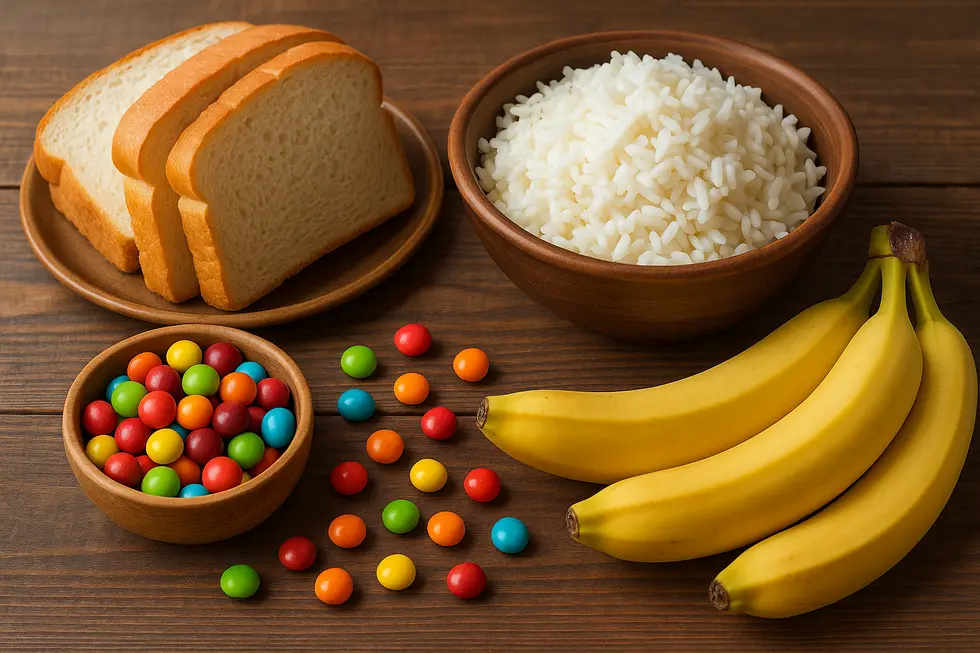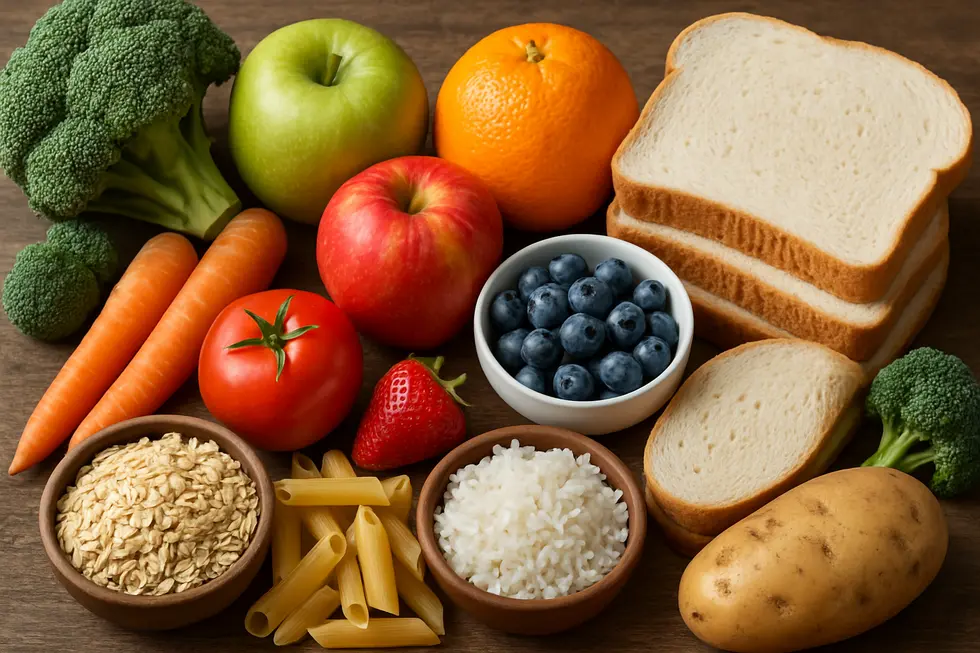High glycemic carbohydrates are a significant concern for individuals keen on maintaining a stable blood sugar level, especially diabetics. These rapidly digested carbs cause quick spikes in blood glucose, posing challenges to metabolic health. Knowing which foods fall into this category and how to balance them can empower you to make healthier choices. The upcoming chapters will delve into specific examples of high glycemic carbs and provide actionable strategies for managing their impact.
Understanding High Glycemic Carbs: A Closer Look at Common Culprits

High glycemic carbohydrates have a notorious reputation for being adept at causing swift changes in blood sugar levels. Found in a myriad of daily food choices, these carbs can seamlessly integrate into our diets without us realizing their glycemic consequences. Understanding which foods fall into this category is essential for making informed dietary choices.
The Usual Suspects in Processed and Starchy Foods
When it comes to high glycemic carbs, a significant portion hails from processed and starchy foods. Cereals, especially those that are sugar-laden or refined, are a prime example. These breakfast staples often provide a quick sugar rush followed by an unmistakable energy crash. Similarly, foods such as corn chips and doughnuts pack a high glycemic punch, with their refined flour and sugar content leading to rapid digestion.
Fast-food favorites like French fries and fried chicken are not exempt either. The very methods used to prepare these foods—frying in oils—further enhance their glycemic impact. Although delightful to the taste buds, these foods are best swapped out for healthier, low glycemic alternatives.
Mashed potatoes deserve a special mention. Although potatoes in their natural form can offer nutrition, when mashed, their glycemic index metric rises considerably compared to their boiled or baked counterparts. Similarly, pizza, with its refined flour crust and often sugary sauces, is another commonly consumed food that exerts a high glycemic effect.
Nature’s Sweet Bounty: High Glycemic Fruits
Fruits, often praised for their health benefits, can sometimes surprise us with their glycemic profiles. While fruits are a source of essential vitamins and minerals, some, like mangos, bananas, pineapples, and watermelon, possess higher glycemic indices. These fruits contribute to swift blood sugar peaks when consumed in large quantities or without balancing lower glycemic components such as protein or fiber.
Dried Fruits: Concentrated Sugar Bombs
Dried fruits pose their own unique challenges. Gone through the process of dehydration, these fruits become concentrated sugar sources. Often, they come with added sugars, further heightening their glycemic index. For individuals aiming to moderate their sugar intake or manage conditions like diabetes, dried fruits should be consumed sparingly and mindfully.
The Hidden Sugar Sources in Everyday Foods
What makes high glycemic foods particularly tricky is that they often hide in plain sight. Several processed foods, marketed as convenient meal options, contain hidden sugars that can unpredictably elevate blood glucose. Bottled salad dressings, canned soups, frozen dinners, and various condiments may seem innocuous but often contain sugar-rich ingredients that deceive even a conscientious eater.
Processed foods, which prioritize shelf life and flavor enhancement, are a common grocery store staple. However, they underscore the importance of reading labels and understanding the composition of the foods we eat.
Strategic Approaches to Managing High Glycemic Carbs
Armed with knowledge about these high glycemic foods, implementing strategies to balance carbohydrate intake becomes crucial. Opting for low glycemic alternatives and pairing high GI foods with proteins or fibers can mitigate the glycemic effect. Moreover, specific cooking methods, like cooling and reheating starchy foods, can lower their glycemic impact, as evidenced by classic examples such as potatoes.
Additional Resources and Guides
For a more in-depth exploration and strategic plans to manage these foods within your diet, various resources are available. Websites like the Glycemic Index Guide offer extensive information on managing one’s diet for better blood sugar regulation.
Incorporating these insights into daily dietary habits not only assists with immediate energy management but also plays a crucial preventative role against long-term health issues such as type 2 diabetes and cardiovascular disease. By being selective and informed about our carbohydrate choices, we maintain better control over our health journey.
Mastering Energy Levels: Strategies for Balancing High Glycemic Carbs

Understanding the Role of Glycemic Index in Dietary Balance
To effectively manage high glycemic carbs, it’s crucial to first understand the glycemic index (GI) and its impact on our diet. The glycemic index is a tool used to rank carbohydrates on a scale from 0 to 100 based on how quickly they increase blood sugar levels. Foods are categorized into low GI (1-55), medium GI (56-69), or high GI (70 and above). High glycemic index foods, such as white bread, sugary snacks, and many processed products, cause rapid spikes in blood sugar, often leading to energy crashes and increased hunger shortly after consumption.
Understanding the intricacies of the glycemic index isn’t merely an academic exercise; it furnishes you with practical knowledge about how different foods affect your physiology. Besides the intrinsic properties of food, factors such as food processing, preparation, and ripeness can significantly alter the GI of what we eat. For example, ripe fruits have a higher GI than their unripe counterparts, and cooking methods can either raise or lower the GI of foods like pasta and rice. Therefore, being informed about these variations can empower you to make better dietary choices.
Moreover, this understanding informs not only meal choices but meal timing and composition. Pairing high GI foods with protein, fiber, and healthy fats can mitigate rapid glucose absorption. Proteins and fats slow down digestion, stabilizing blood sugar levels and preventing insulin spikes, which are pivotal in managing energy levels and reducing risks associated with insulin resistance and type 2 diabetes.
Balanced Eating Strategies for High Glycemic Carbs
Managing your consumption of high glycemic carbs necessitates a balanced dietary strategy. This involves integrating low GI foods like whole grains, legumes, nuts, and vegetables into your meals. Whole grains like oats are known to offer substantial benefits in blood sugar management due to their complex carbohydrate structure and fiber content. Incorporating such grains can help sustain energy levels, which is crucial for anyone, regardless of whether they have metabolic challenges.
Proteins, such as those found in chicken, fish, and legumes, not only help in building muscle mass but also play a critical role in controlling blood sugar by providing slow-digesting energy. Similarly, beneficial fats, found in foods like avocados and oily fish, are vital for a balanced diet and further aid in slowing carbohydrate absorption. The interplay between these nutrients creates a stable blood sugar profile, reducing the likelihood of energy dips and cravings for unhealthy snacks.
Meal timing and portion control are equally indispensable. Regular meal intervals prevent the sudden dips in blood sugar that often lead to overeating or choosing high glycemic snacks. It’s also indispensable to pay attention to portion sizes, which helps in controlling post-meal blood sugar spikes—thus protecting against long-term health issues.
For anyone managing diabetes, these approaches are especially critical. They reinforce the importance of nutritional awareness and proactive food planning, which are key elements in maintaining an optimal lifestyle. Further insights into dietary balance for diabetes can be explored at sources dedicated to nutritional strategies for blood sugar control, such as Cleveland Clinic’s Glycemic Index guide.
Practical Tips for Everyday Management
Adopting practical strategies for handling high glycemic carbohydrates can make a marked difference in both immediate well-being and long-term health outcomes. One essential habit is reading nutrition labels meticulously to discern hidden sugars and high GI components. Planning meals in advance allows for a more conscientious approach to managing carbohydrate intake and facilitates a balanced blend of nutrients.
Keeping a food diary can be a powerful tool, offering personal insights into how different types of foods affect your blood sugar levels. This personalized data becomes invaluable for making informed dietary adjustments that cater specifically to individual responses, rather than relying solely on generalized diet plans.
Concentrating on whole, unprocessed foods rich in fiber and nutrients is also crucial. Feeding your body with such foods can help you maintain stable blood sugar levels throughout the day. When it comes to low glycemic vegetables, they offer their own unique benefits, which you can explore further at Low Glycemic Vegetables Benefits.
Switching from high to low glycemic foods doesn’t mean you must sacrifice taste or satisfaction. Many low glycemic foods, like sweet potatoes, lentils, and berries, are delicious and offer a variety of textures and flavors. There’s a whole world of culinary possibilities that align with a health-conscious lifestyle.
Implementing these strategies is not just about addressing current health challenges; it’s a profound shift towards preventive health. By understanding and managing your glycemic response, you’re investing in better energy management, improved mood stability, and a foundation for lifelong wellness.
Final thoughts
Understanding and managing high glycemic carbs is crucial for anyone looking to maintain stable energy levels and good health. By identifying high glycemic foods and implementing effective management strategies such as portion control and food pairing, you can mitigate their adverse effects. Make these adjustments part of your dietary habits to better support your metabolic health.
Don’t just read about better health—live it. Download the Glycemic Index Guide Tracker today to start making smarter food choices, track your glucose, and stay on top of your nutrition—all in one app.
About us
Glycemic Index Guide Tracker is a powerful yet easy-to-use mobile app designed to help you make informed dietary choices by tracking the glycemic index (GI) and glycemic load (GL) of the foods you eat. Whether you’re managing diabetes, following a low-carb or keto diet, or simply aiming to maintain steady energy and better health, the app offers a comprehensive food database, nutrition and glucose tracking tools, weight monitoring, and curated low-GI recipes—all in one intuitive interface. It’s your go-to companion for understanding how different foods affect your blood sugar and for building smarter eating habits.


Leave a Reply